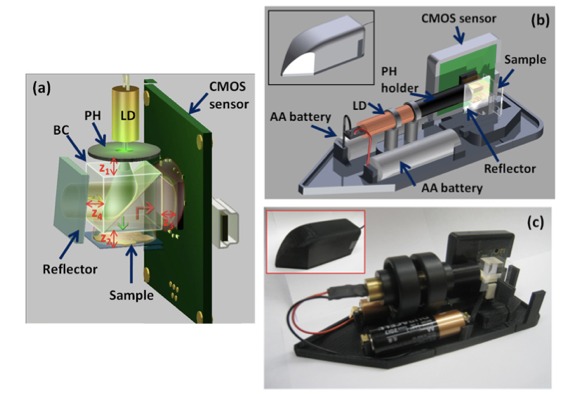Imagine a relatively small sub-$100 microscope that can probe the food on your plate (or the blood pumping through your body) using a laser instead of lenses. Also: it’s capable of using that laser to produce holographic images. No, not Holodeck-caliber simulacrums, but sophisticated 3D images of dense surfaces, say your skin (see the image up top).
The fancy-schmancy term for that last bit? Lensless holography. And here’s the kicker: it only needs a couple household batteries to function.
(PHOTOS: What Booze Looks like Under a Microscope)
It’s purpose: to aid medical workers by providing a cheap and portable optical imaging tool that weighs just 200 grams—about as much as a standard bar of soap.
“Due to its compact, cost-effective, and lightweight design, this dual-mode lensless holographic microscope might especially be useful for field-use or for conducting microscopic analysis in resource-poor settings,” write researchers in an academic paper that details the microscope’s functionality. The microscope itself was created at the University of California, Los Angeles (UCLA).

Schematic diagram and photograph of the lens free holographic microscope. Photo: Biomedical Optics Express
It’s also dual-mode, meaning it can transmit as well as reflect images. In transmission mode, it can be employed to analyze liquids, say to scan water for bacteria like E. coli. In reflection mode, it’s “reflecting” what it sees back as a hologram, crafting a 3D image of whatever it’s pointed at.
“You take a laser and you split the beam in two using a mirror. Then you use one of these beams to illuminate your sample,” Dr. Karl Ryder of Leicester University’s Advanced Microscopy Center told BBC News. “You can then recombine these two beams using clever mathematics to build a 3D image of your object.”
The reason it’s so cheap: It’s cobbled together using inexpensive components, and doesn’t require the sort of dense, costly lenses found in traditional microscopes.
From pen laser to—almost—pen microscope?
MORE: Insulin Pumps, Monitors Vulnerable to Hacking
Matt Peckham is a reporter at TIME. Find him on Twitter at @mattpeckham or on Facebook. You can also continue the discussion on TIME’s Facebook page and on Twitter at @TIME.

